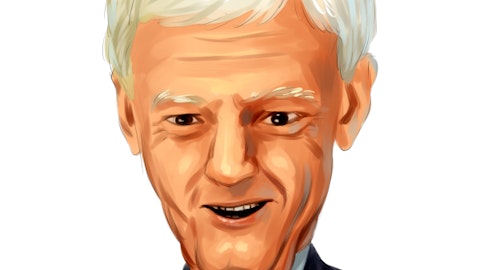In this article, we discuss the top 5 stock picks of Julian Robertson’s Tiger Management. If you want to see our detailed analysis of Robertson’s history, investment philosophy, and hedge fund performance, go directly to the Top 10 Stock Picks of Julian Robertson’s Tiger Management.
5. Micron Technology (NASDAQ:MU)
Tiger Management’s Stake Value: $41.5 million
Percentage of Tiger Management’s 13F Portfolio: 8.15%
Number of Hedge Fund Holders: 83
Micron Technology (NASDAQ:MU) is an Idaho-based producer of computer memory and computer data storage solutions, including dynamic random-access memory, flash memory, and USB flash drives.
Julian Robertson’s Tiger Management owned 446,300 shares in Micron Technology (NASDAQ:MU) at the end of December 2021, worth $41.6 million, representing 8.15% of the portfolio of the fund.
Marshall Wace LLP is the biggest stakeholder of Micron Technology (NASDAQ:MU) as of the end of the fourth quarter, according to the data tracked by Insider Monkey. Overall, 83 funds were bullish on Micron Technology (NASDAQ:MU) by the end of the December quarter, compared to 63 in the previous quarter.
In its Q1 2021 investor letter, Bonsai Partners, an asset management firm, highlighted a few stocks and Micron Technology (NASDAQ:MU) was one of them. Here is what the fund said:
“Micron is a manufacturer of memory semiconductor chips. Micron appreciated 17.3% during the quarter.
With the semiconductor cycle in full swing, sentiment continued to improve for major DRAM and NAND suppliers. Spot pricing for DRAM continues its upward march due to supply shocks across the industry and sustained demand levels that continue to outstrip supply.
As a result, Micron showed improving results for the fiscal first quarter, raised guidance intra-quarter for the fiscal second quarter, and offered strong guidance for the fiscal third quarter in both growth and margins.
While the cyclical nature of DRAM hasn’t changed, the cycles themselves continue to become more benign, leading to long-term economic improvement across these businesses. Micron is now continuously profitable, with industry players in a dramatically stronger position than even just five years ago.
The biggest negative surprise in the quarter came from Micron’s exit from its 3D XPoint hybrid memory business. The company also announced its decision to sell its accompanying Utah fab. Fortunately, this development does not alter the investment thesis much since 3D XPoint was an option ticket for future growth. While it’s unfortunate this product didn’t pan out, now is an excellent time to sell a fab, so perhaps it is a blessing in disguise?”




